ASUS' N82Jv: Jack-Of-All-Trades
by Jarred Walton on September 11, 2010 11:10 PM ESTASUS N82Jv-X2 Low and Medium Gaming
Following our new testing procedure, our gaming results for this midrange GPU and system will look at Low, Medium, and High quality settings. It should come as little surprise that High settings are typically too much for most titles, but we'll get to that in a moment. First, let's start with a look at Low and Medium testing. Again, the M11x R2 and A660D are going to be the main comparison points; the former has the same GPU with a slower (and lower power) CPU, while the latter comes equipped with AMD's "equivalent" of the GT 335M.

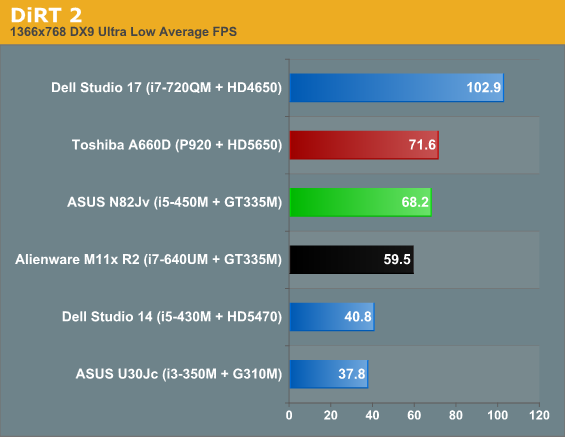
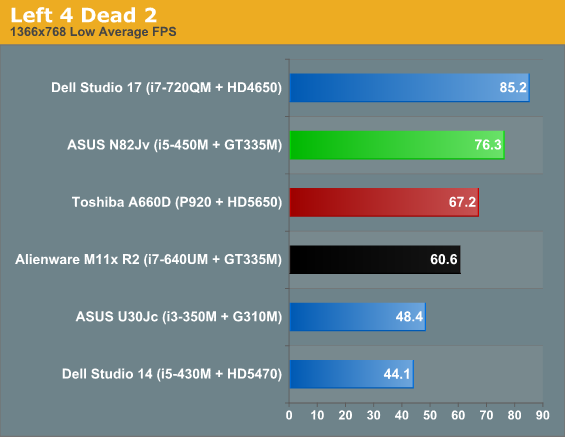
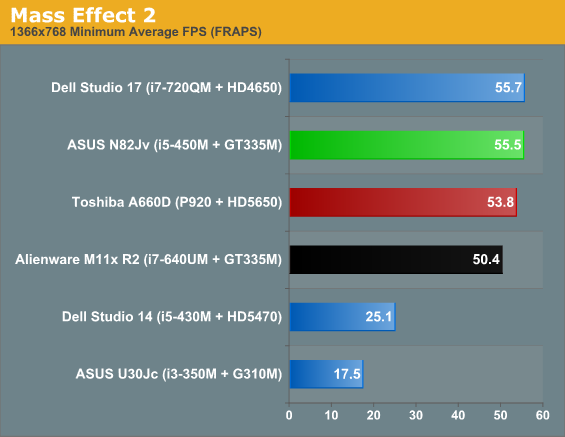
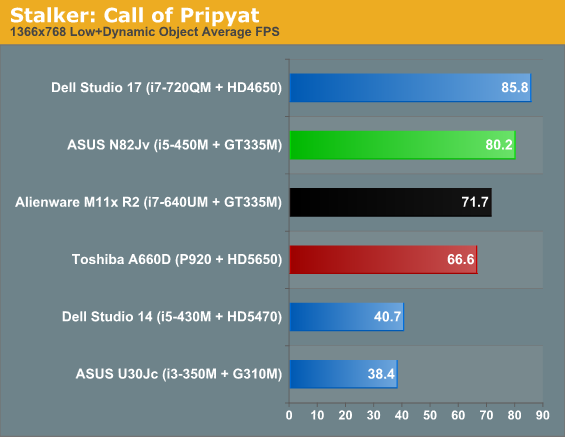

Low quality settings aren't where the GT 335M is designed to play, so frame rates are generally close to or above 60 FPS. The faster CPU in the N82Jv certainly shows up, though it's not the knockout blow you might expect. ASUS beats the M11x R2 by an average of 17% at low detail settings; we expect the margin would grow a bit if we compared with the i5-520UM equipped M11x, but even then there are hints that the system is becoming GPU limited. The lead over the A660D with HD 5650 ends up being 12% on average, but with the A660D winning out by 6% in DiRT 2. Also note that Toshiba is using lower clocked 450MHz 5650 chips, plus the P920 as we already showed is no performance powerhouse, so HD 5650 at 550MHz should come out on top of GT 335M by 10% or more.
A quick look at the Dell Studio 14 also shows why we don't like the gap between 5470 and 5650 in AMD's mobile GPU lineup: outside of StarCraft II, the N82Jv/GT 335M ends up being nearly twice as fast as the HD 5470. The reason StarCraft II doesn't conform to the other results is that Optimus tends to create a few bottlenecks when frame rates get above 60 FPS. Remember that Optimus transfers the completed frames over the PCIe bus to system memory, so you're dealing with memory bottlenecks as well as PCIe congestion. For 1366x768, we're only looking at around 240MB/s of bandwidth, so that shouldn't cause too many issues, but clearly something is holding back the Optimus systems in SC2.
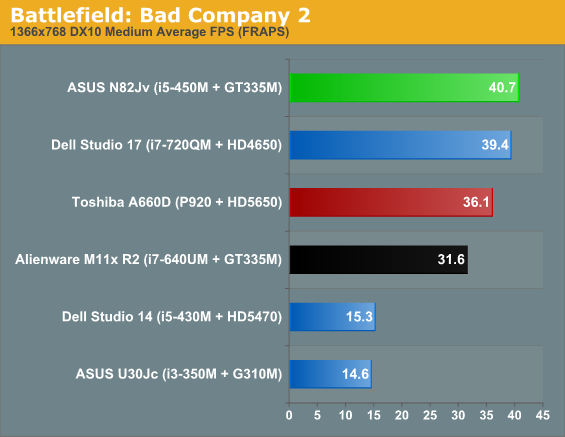
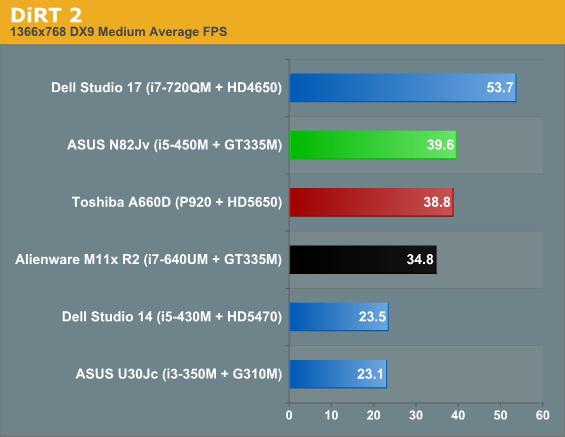

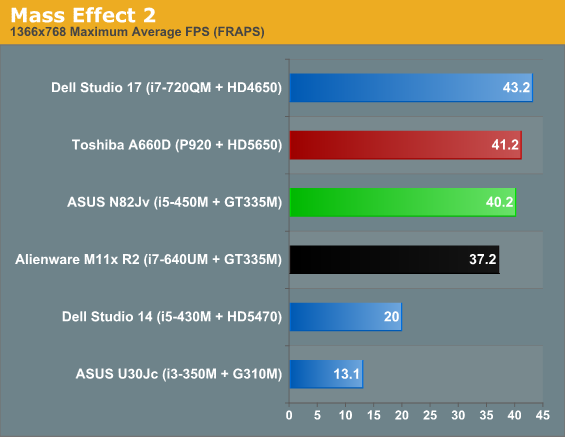
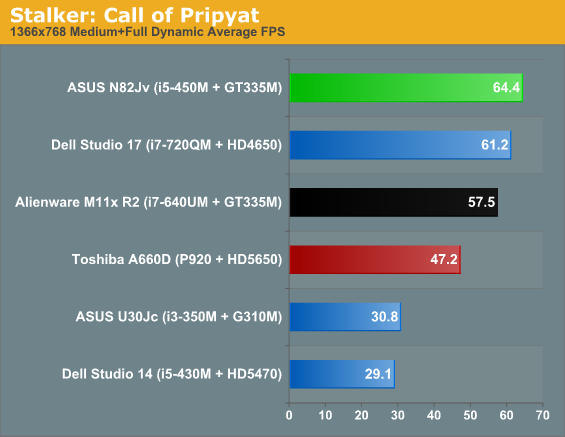
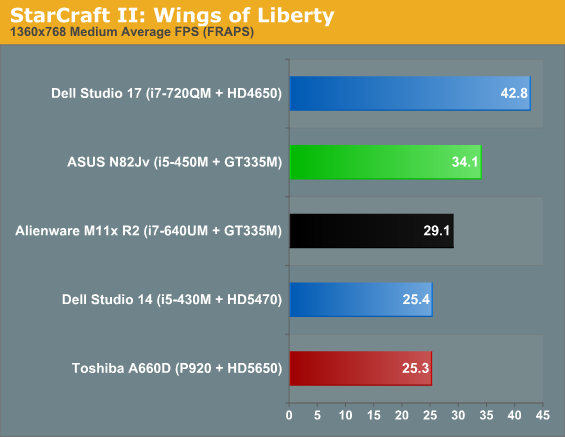
Moving up to Medium details doesn't radically alter the picture, although some of the gaps change slightly. The lead over the M11x R2 drops to 14%, indicating we are becoming more GPU bound. The N82Jv is 13% faster than the A660D, which is nearly the same as the low detail results, but a look at the individual games shows AMD moving into the lead in L4D2 and ME2 by a small margin, while in STALKER and SC2 the GT 335M lead grows to around 35%. How much of the lead comes from the CPU difference vs. the GPU difference isn't entirely clear at this point, though we should have an Acer AS5551G-4591 in house next week to shed some light on things. Also note that the lead over the Studio 14 jumps to 92% average, or 103% if we drop the lower 34% lead in SC2. (Note to Dell: We'd love to see the Studio 14 with an HD 5650!)
Medium quality gaming is where the GT 335M comes into its own. All of the games are at 40FPS or higher, except for SC2 where our intense benchmarking sequence drops average frame rates to 34FPS—still very playable for an RTS! These are all recent titles that can tax laptops quite a bit, and there are plenty of older/less taxing games that will work great on midrange mobile GPUs (World of WarCraft should break into the 60+ FPS range, for example). Is a $1000 laptop going to come anywhere near a $1000 desktop? Not a chance… but then you can't pick up your desktop and walk out the door to go to a LAN party in 60 seconds flat.










33 Comments
View All Comments
FH123 - Sunday, September 12, 2010 - link
Good grief, how do you come up with those numbers? Show some consideration for people with different (yes, probably worse) eyes than yours. My preference is for 1024x768 at 14". My gripe is that the choice has gone away. My next choice would be 1280x800. Even that wasn't available in the low-weight, premium machine I bought. My ultimate choice would be something close to (laser) printed quality, e.g. 300 dpi upwards, and all the scaling problems solved by the OS. In the meantime, while we're at the resolutions you mention, I inevitably end up using some form of anti-aliasing, e.g. ClearType. That doesn't exactly make things better at the sort of awkward neither here (traditional screen < 100) nor there (traditional printer > 300) DPI we have at the moment.seanleeforever - Monday, September 13, 2010 - link
as a owner of both the BEST notebook screen in business, i think i know what i am talking about:screen resolution has absolutely NOTHING to do with screen quality, period. you guys are simply drinking Kool-Aid that notebook company tend to sell you. a higher resolution screen doesn't make it better than lower resolution screen, just as a 17 inch notebook is not better than 12 inch notebook (except it is larger).
the technology used in the panel is what decides screen quality. i have HP dream color 2 on my elitebook and outdoor screen on my x201 tablet. both uses 10 bit IPS screen that delivers superb image with NO color distortion at any angel, both are 300~400 dollar option on the top of the SAME RESOLUTION screen.
a good screen cost A lot of money, much higher than simply put more pixel on the screen. that's why notebook manufacturers try to fool you.
simply put, i will love to a 1200*800 ips than blue LED TN screen of any resolution.
Roland00 - Sunday, September 12, 2010 - link
You don't need direct x 11 with a laptop. Any game that you would want direct x 11 you would want a card that is faster than a 9800gt (aka 5750 or GTS 450 desktop parts) or else the card would be too slow to perform an acceptable frame rate with direct x 11 effects added on. Now in theory a game could be "completely" direct x 11 where you wouldn't have a direct x 9 or direct x 10 mode but this won't happen for games are developed for consoles and are developed for pc marketshare and too few people have direct x 11 cards thus their will be a direct x 9 and/or direct x 10 code path.That said the upcoming 400 series nvidia cards are looking to be faster than this card for they have a higher amount of shaders (the 420m, 430m, and 435m will all have 96 shaders, the difference between each model is the core clock and the shader clock, they have identical memory bandwidth). Whether this will provide an insignificant boost slightly different architecture, and/or memory bandwidth is anybody guess but I wouldn't be surprised to see at least a 20% performance boost for they have 25% more shader hardware, and all even the 420m has higher clocks than the 335m. (and the 435m is 30% faster on the core and shader clock compared to the 420m).
Get the 400 series not because of direct x11 but because it will be a faster card, and battery life isn't a big deal due to optimus.
Voldenuit - Sunday, September 12, 2010 - link
What use is a low-end DX11 GPU? Even midrange desktop DX11 GPUs struggle with DX11 games, so they are doubly useless on a laptop.A DX10 GPU can do most anything a DX11 one can.
DirectCompute? Check.
CUDA? Check.
OpenCL? Check.
PhysX? Check (not that you'd want to turn on Physx on a laptop, unless you were a masochist).
If you're building a high end (or even midrange) desktop, DX11 is the clear choice, but on the mobile front, it's hardly essential.
I do agree that with the shoddy battery, lousy screen and mediocre keyboard, there isn't much to entice me with the ASUS in any case.
Aaluran - Sunday, September 12, 2010 - link
I couldn't possibly agree more with this article. The LCD is an annoyance, but one I can live with, but that battery is laughable compared to the 84Wh one. This laptop is perfect as a second computer, but 47Wh is simply unaccpetable.strikeback03 - Monday, September 13, 2010 - link
That is one point I disagree on, IMO 3-4 hrs is good enough for a lot of mainstream users. Make a larger one available (as part of the purchase) for those who want it, but I find the LCD far more a problem than the battery.blackrook - Sunday, September 12, 2010 - link
The last two pages of this article just scream "HP Envy 14 with radiance screen!" to me. It's a huge shame Anandtech doesn't appear to have one on hand. I was surprised it was never mentioned. This is a laptop with:-magnesium/aluminum chassis
-switchable 5650 graphics (albeit underclocked and not Optimus)
-sensational screen
-acceptable battery capacity (59Wh?)
And it seems to be making waves. The Envy 14 upon initial release originally came standard with the radiance screen at $1099, until demand seemed to outpace supply. It became $999 with a standard brightview screen, radiance being as a $200 option. Since then the radiance screen has ballooned to a $300 premium. That's how much perceived value a quality screen is worth to consumers, and it stuns me why more manufacturers haven't tried to go the same route HP has with the Envy 14.
Just some food for thought.
The Crying Man - Sunday, September 12, 2010 - link
Jarred mentioned that an Envy 14 was on it's way some weeks ago. Hopefully it's in the process of being reviewed now.JarredWalton - Sunday, September 12, 2010 - link
It still hasn't arrived... it seems HP can be like that. Plus, the current Envy 14 is now what, 6 months old? It's about due for an update.blackrook - Sunday, September 12, 2010 - link
It released in late June, and first day buyers started receiving them early July. So that'd make it around two and a half months old.So HP was supposed to send over a review unit and it never arrived? :S
*shakes head*